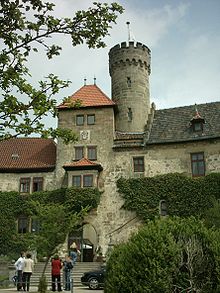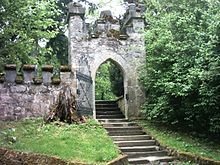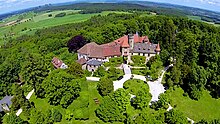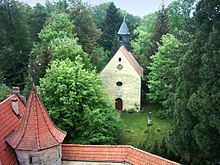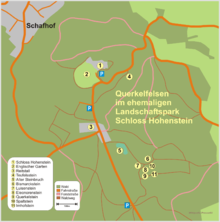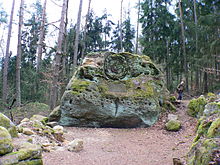Hohenstein Castle (Upper Franconia)
Hohenstein Castle, first mentioned as a castle in 1306, is located on a wooded sandstone ridge in the Hohenstein district of the municipality of Ahorn , six kilometers southwest of Coburg in the Bavarian Upper Franconia ( Germany ).
history
Hohenstein Castle
Today's Hohenstein Castle was first mentioned in 1306 as "Castum Hohenstein in dem Grabfelde", ie as a castle. Countess Jutta von Henneberg was registered as the owner . In the following 150 years the summit castle changed hands several times up to Duke Wilhelm of Saxony, who gave the castle hat "to the Hohen Steyn" to the brothers Hans and Thomas von Lichtenstein as a fief . In 1466 the Bamberg vassals Kunz von Aufseß and Kunz von Streitberg , whose family castles were in Franconian Switzerland , devastated the castle. Both knights and their brother Kunz Ochs, who was also involved, were soon condemned by the Coburg council court to compensate for the damage and to pay 4,000 guilders to the Coburg rule for breach of the peace .
In May 1521 the robber baron Thomas von Absberg attacked a group of returnees from the Reichstag in Worms on the Knittlinger Steige near the Maulbronn monastery . Two very prominent personalities fell into his hands: Hans Lamparter von Greiffenstein, the emperor's spokesman, and Johann Lucas, who handled financial transactions on the emperor's personal behalf. Absberg first brought the two imperial councilors to Hohenstein Castle. There they lay in the tower for many weeks. The enormous ransom demands were not met, but the kidnapping triggered the Franconian War by the Emperor and the Swabian Federation in 1523 .
In 1525 rebellious farmers from the hordes of Thomas Münzer invaded and burned the medieval castle to the ground. Part of the square tower of the southern outer bailey was preserved as a ruin next to the castle chapel.
Castle Hohenstein
The uninhabitable remains of the castle, still in the fief of the von Lichtenstein family, were only converted into a Renaissance style castle by Michael von Lichtenstein in 1573 , as an inscription on the so-called Lichtenstein building attests to. The high gatehouse was also built during this time. The round tower, to which the gatehouse nestles, is six years older and offers views of the surrounding castles of Banz and Callenberg , the Basilica Vierzehnheiligen , the Veste Heldburg and the Altenburg near Bamberg from its crenellated crown .
Shortly before the end of the Thirty Years' War , the castle was looted by "Swedish peoples" in 1648 and five years later sold to Christof von Thüna, bailiff at Schauenstein ( Brandenburg ). Thüna bequeathed the property to his five daughters in equal parts. The youngest heiress married Johann Helmhard Auer von Herrenkirchen, who paid off his sister-in-law and was able to keep the castle in the family for three generations. In 1741 the chamberlain Adam von Schauroth from Ansbach acquired the property for 65,000 Franconian guilders and 200 ducats of patronage money for ongoing use and sold it 18 years later to the Brunswick Lieutenant General Philipp Ernst Freiherr von Imhof (spelling on some memorial stones also "Imhoff"). The new owner had the palace rebuilt according to his own ideas and initially laid out the palace garden in the Rococo style , which his descendants expanded into a romantic park. In 1937 the von Imhoff family sold the castle, but kept the land to this day.
In the Third Reich the castle from 1941 was first of the imperial post as postal rest home use and after the Second World War by the German Federal Post Office to the Caritas leased to a nursing home instituted. In 1976 the Post sold the property to Munich entrepreneur Oskar Hacker, who had the castle restored between 1987 and 1993 in order to open it as a guest house with a wine bar and restaurant . In 1996, Hacker leased his castle to the hotel company Kötterl & Wandt, which continued to run it as a castle hotel with fine dining. The castle has been owned by the non-profit Oskar Hacker Foundation based in Munich, whose board members are Ralph Veil, Silvia Hacker-Notary and Ingo Michael Regner since 2016. The palace and the park will be renovated and restored in 2020; From August 15, 2020, it is leased to a new operating company that will start operations on October 1, 2020.
Hohenstein community
The community Hohenstein was incorporated into the community Schafhof on June 20, 1898 .
Castle chapel
In the second half of the 17th century, Christof Freiherr von Thüna, whose marriage coat of arms is affixed above the portal, had the castle chapel built within the original medieval castle complex. The rectangular building, the roof of which is adorned by a turret with a double belfry , closes off on three sides to the south with the sanctuary. Above the continuous interior of the chapel with its simple wooden ceiling, a single gallery rises to the north and a double gallery to the east . The pulpit with its magnificent sound cover carved from wood is dated to 1688 . A tomb of Johann Helmhard Auer von Herrenkirchen († 1718) is behind the altar. The epitaph of Philipp Ernst von Imhof († 1768) on the west wall of the church is richly designed. From 1749 to 1751 the Franconian church musician Johann Heinrich Zang worked as an organist at Hohenstein Castle. The organ he used from 1709 is only preserved in fragments in the organ gallery above the simple altar.
Rococo Park
The park, which the von Imhof family had laid out around Hohenstein Castle over a period of more than 150 years, basically reflects the principles of the late romantic English garden , but interspersed with elements from the family history of the von Imhof and their reverence for the history of the empire. This makes the Hohenstein Palace Park very different from the other well-known landscape gardens in the Coburg, Bayreuth and Bamberg areas. In order to be able to realize the views and lines of sight required by the romantic garden art, smaller farm properties were demolished and the dense forest was replaced by native and overseas trees. Cellars were transformed into grottos, stone views created, benches and winding paths laid out, castle walls with a crenellated observation tower built and a monopteros set up next to a small artificial waterfall. Open spaces with romantic herbaceous beds, arcades and outside stairs and the obligatory theater stage as well as a half- timbered porter's house were created. A picturesque Franconian led linden tree (umbrella linden tree) is also part of the garden ensemble. Of the many exotic tree species that have been planted, there are still stately specimens in the park of Hohenstein Castle, regardless of the entire complex, which was increasingly abandoned in the 20th century. Since 2001, a registered association has been providing the necessary support for the restoration of the palace garden in its original form from the point of view of monument protection . The views and visual relationships, which formerly stretched far into the Coburg and Bamberg Lands, are overgrown, but the publicly accessible park is still a gem among the Franconian landscape gardens.
Former landscaped garden
Scattered sandstone formations protrude from the eastern mountainside of Hohenstein Castle in the direction of the village of Stöppach . In the 19th century, the Imhof castle owners had part of the rocks worked. This is how staircases, grottos, stone benches, reliefs and even two wooden huts set on the rocks were created. The ensemble received the staffage of a landscape garden . The predominantly young forest population today allows the conclusion that the area was much more open in the past and allowed wide views of the landscape. Between the rocks connected by signposted paths there are also some benches carved out of sandstone. A legend has been handed down about the formation of the rocks.
The Querkel legend
According to legend, more than five dozen dwarfs, called Querkel in Franconia, lived and worked on the Hohenstein mountain . They diligently mined the gold and silver in the mountain . They also helped the farmers in the nearby village of Stöppach with the wintry threshing and occasionally brought gold ducats with them or gave the children sparkling stones. For this they received bread and smoked food for Vespers from the farmers' wives . They also helped poor people with the harvest and made themselves useful in the stables. So prosperity soon returned to the village. But once a farmer's wife forgot to prepare supper for the Querkeln, and when they couldn't find the usual Vespers in the kitchen after their work was done, they opened the storage chest to get their share. The avaricious and avaricious farmer caught them and beat them with a pizzle , believing that they had taken more than they were entitled to. In their distress, the little men jumped howling through the door and window and fled back to the Hohenstein. There they packed up their belongings and their gold and silver treasures to leave the Hohenstein. But before they left that night when all the farmers were asleep, the disappointed Querkel threw huge blocks of stone down the slope in anger, but they did not hit the village and remained on the slope. From then on, the helpful little men were never seen in the area again. The Stöppach farmers waited in vain for their helpers. In search of them, they found the rocks on the slope that had previously crowned the mountain. The prosperity in the village was now over. Soon Stöppach could no longer be distinguished from the neighboring communities in his poverty. They gave the rock formations on the mountain slope the name Querkelfelsen, as they are still called today.
The Querkfelsen
The Querkelfelsen can be explored from the signposted narrow path immediately south of the riding arena past the old quarry. Circular route signs have been showing the way since 2011. Location signs with the names of the rocks are located on the respective formations.
Querkelstein
A staircase carved into the rock with twelve steps leads to the Querkelstein. According to the traces, there was originally a wooden viewing platform on the rock.
Imhofstein
In 1898 the initials "GI" were carved into the Imhofstein, in memory of Gustav von Imhof, who had the last major renovations carried out on the palace in 1890, such as the new construction of the south-east wing and a tower with an outside staircase in the palace garden. On May 1, 1891, through his initiative, a public concert took place at the Querkelsteinen, which was attended by 500 people. The concert series continued for a few years.
Luisenstein
On the Luisenstein is the oldest year 1850, which is crossed by an "L". The "L" stands for Luise von Molke, the wife of the 5th Imhof.
Eleanor's Stone
The Eleonorenstein is reminiscent of Gustav von Imhof's third wife with a glass plate attached to the rock from 1910.
Bismarckstein
On the Bismarckstein there is a large bronze relief with the year 1899 and the inscription "The Chancellor of the New German Reich". A mighty staircase carved into the rock leads to the relief.
Split stone
The split stone (without processing) actually consists of two rocks lying next to each other, which allow the path uphill through a narrow passage.
Devil stone
The Teufelsstein is located well north of the other formations. Around 1815 it was equipped with a hut that was reached via two stone stairs and a wooden bridge in between. The wooden structures are no longer there. Stone staircases and bridge abutments, however, are still well preserved.
literature
- Fritz Mahnke: Palaces and castles in the vicinity of the Franconian Crown. Tape. 1st 3rd edition. Neue Presse GmbH printing and publishing company, Coburg 1974.
Web links
- schlosspark-hohenstein.de Association of Friends of the Hohenstein Castle Park eV
- schlosshotel-hohenstein.de Schlosshotel Hohenstein
Individual evidence
- ^ Fritz Mahnke: Palaces and castles in the vicinity of the Franconian Crown. Tape. 1st 3rd edition. 1974, pp. 41-42.
- ^ Fritz Mahnke: Palaces and castles in the vicinity of the Franconian Crown. Tape. 1st 3rd edition. 1974, p. 43.
- ^ Fritz Mahnke: Palaces and castles in the vicinity of the Franconian Crown. Tape. 1st 3rd edition. 1974, pp. 44-45.
- ^ Wilhelm Volkert (ed.): Handbook of Bavarian offices, communities and courts 1799–1980 . CH Beck'sche Verlagsbuchhandlung, Munich 1983, ISBN 3-406-09669-7 , p. 441 .
- ^ Fritz Mahnke: Palaces and castles in the vicinity of the Franconian Crown. Tape. 1st 3rd edition. 1974, p. 44.
- ↑ Rainer Graefe: Buildings from living trees. Guided dance and court linden trees . Geymüller, Publishing House for Architecture, Aachen [u. a.] 2014, ISBN 978-3-943164-08-4 , pp. 78 f .
- ^ Association of Friends of the Hohenstein Castle Park eV: A park also needs love . Reichel Communication, Darmstadt 2006 (Flyer).
- ↑ Ulrich Göpfert: The Querkelfelsen at Hohenstein Castle. A legend from the Coburg region.
- ↑ Julius Lippert : Christianity, popular belief and popular custom. Historical development of their conceptual content . Hofmann, Berlin 1882, p. 444 ( archive.org ).
- ↑ a b Querkelsteinweg. On Outdooractive.
- ↑ a b c d Fritz Mahnke: Palaces and castles in the vicinity of the Franconian Crown. Tape. 1st 3rd edition. 1974, p. 45.
Coordinates: 50 ° 13 ′ 3 ″ N , 10 ° 56 ′ 2 ″ E
